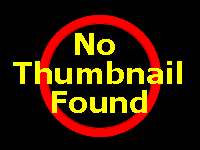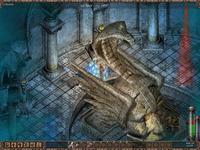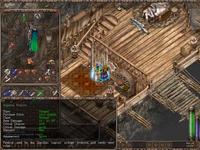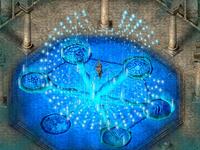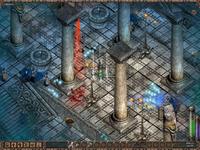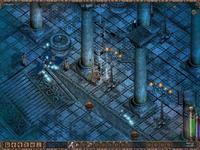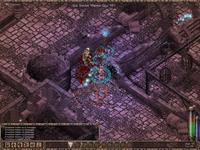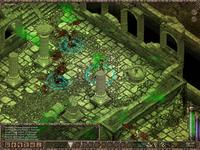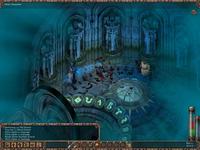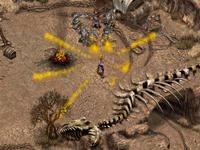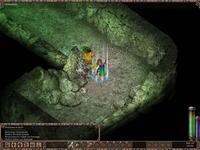|
|
|
Main News Forums Games Games Database Top 100 Release List Support Files Features Reviews Previews Interviews Editorials Diaries Misc Download Gallery Music Screenshots Videos Miscellaneous Staff Members Privacy Statement |
Kult: A Hands-On Preview
That ‘Kult: Heretic Kingdoms' is an unusual action-RPG comes as less of a surprise when you consider its heritage. The first project of Slovakian developer 3D People, the talent of UK script-consultants International Hobo was added late in the project to focus the story and gameplay. Throw in a Dutch publisher for good measure and you might have some sense of the different influences. I've had the opportunity to spend around a dozen hours so far with a preview version, so read on for some impressions. Getting StartedKult is set in the Heretic Kingdoms - a land of political turmoil where God was been slain and religion outlawed. Following the murder of the despotic religious ruler the Theocrat some years ago, the Inquisition now searches for and roots out any sign of religion. The player is cast as a female initiate of the Inquisition, assisting her master to locate the Godslayer, a sword of religious symbolism. Character creation is rather simple. After choosing from a selection of hairstyles and starting outfits, it's straight onto allocating points to four basic stats: Melee, Ranged, Magic and Speed. These attributes are graded from F to A (E-, E, E+, D- and so on), with 100 points from the pool used to raise the grade one level. Although this system seems less intuitive than a straight numerical system it's still pretty straightforward. Melee, Ranged and Magic grades directly influence the amount of damage from the respective attack types and Speed modifies the Block and Dodge secondary derived stats. Next, an Attunement is chosen - but we'll cover this in depth a little later. Choose a name - and it's time to enter the Heretic Kingdoms. Kult is a story-driven isometric hack-and-slash action-RPG, set in a distinctive fantasy world. While the basic gameplay is similar to most games in this genre, Kult has several unique twists that colour the experience. Players explore the world of Kult, which consists of around 50 individual maps, undertaking quests from NPCs and engaging in point-and-click realtime combat with enemies. Getting Attuned The first feature that sets Kult apart is the Attunements system, which replaces a more traditional skills and magic scheme and is a central theme in the game. In the Heretic Kingdoms, some people have the ability to synchronise - attune - with the essential nature of objects, unlocking hidden powers known as Attunements. Using or wearing an item during combat increases the sensitivity to the inherent Attunement until it is unlocked, although once unlocked the item is no longer needed. Many Attunements are aligned with an element - Fire, Air, Earth or Water - or a condition such as Melee or No Armour. The character must hold a weapon aligned with the appropriate element or meet the condition (such as No Armour) for the Attunement to work. Despite having interviewed 3D People some months ago and reading the preliminary manual, I didn't really grasp this system until I had played for several hours, so bear with me while I elucidate a little further.
My current character is a "Fire Mage" (there are no classes in Kult but this is the sort of character I was aiming to build) with some ranged abilities for good measure. She has amassed around a dozen Attunements but her current character level restricts her to about 8 currently active Attunements. Her primary weapon is a Shaman's Staff, which basically casts some rather nice variations of fireballs. There's no mana system in Kult, so these can be cast over and over but it takes a few seconds to recharge each time. She also has several useful air-aligned Attunements - including a good defensive aura and Fleet of Foot - but these won't work while she is holding the fire-aligned Shaman's Staff. Switching to an air-aligned Imperial Thunderbow will instantly enable the air Attunements but disable the fire ones. With these two weapons hot-keyed, she can cast a devasting fireball or two then switch to a bow that enables Attunements with better defence and more speed to keep some distance from attackers. Switching back to the Shaman's Staff after a few seconds, it's time for another fireball before selecting the bow and dancing out of reach again. The mix of active Attunements can be changed whenever the character rests, so the player can develop different combinations and strategies and with around 100 Attunements to be found in the game, there's a huge range of possibilities. The impact of finding new equipment is dramatically changed: that new piece might hide an Attunement that once unlocked, completely changes your options. Enter the Dreamworld In addition to the physical world, players can enter the Dreamworld more or less at will - a parallel spirit plane. The Dreamworld occupies the same location as the physical world but is inhabited by spiritual creatures, rather the mundane physical. Entering the Dreamworld might assist in solving quests - you might encounter a useful ghost, for example - but can also be used strategically to escape attackers, approach them from the rear and so on. The Dreamworld has it's own denizens, however, so you may escape some enemy soldiers only to encounter a deadly soulraven. Kult has an innovative approach to healing that seems to work very well. Unlike the ubiquitous healing potion, found in nearly every RPG ever made, characters in Kult are given a herb pouch that can be used at will. This herb pouch represents some simple trail medicine - basic bandages and healing herbs. Each use is a little less effective than the last, representing the increasing wear and tear that trail medicine can't heal. Resting at a campfire or inn completely heals all wounds (and affords an opportunity to change Attunements). This system has a realistic feel while allowing players to adventure longer, before needing to rest and heal. It's all about Story Another disctinctive feature of Kult is the strong narrative and interesting NPCs. While I have only seen part of the story-arc so far, it has been very entertaining and more complex than most action-RPGs. The world of Kult is quite bleak, with different factions vying for power following the death of the Theocrat. Although the story starts with a simple item-hunt, it soon becomes clear that the real story is much deeper and as the player progresses there are some choices (primarily through dialogue options), that ultimately lead to one of six different endings - is your character a staunch defender of the Inquisition, crushing all religion or is the Inquisition ultimately wrong? Refreshingly, the story does not present as a clichéd "save the world from the evil demon/necromancer/mage" but rather one of political intrigue in a very real but troubled world.
As a small example, with the Lord Protector away on official business a power struggle had erupted in the Thieves Guild of one town between the sponsored leader and one of his lieutenants, causing trouble. My character was charged with resolving this crisis - but how and in whose favour was up to me. Progress in the game is quite linear but through optional side-quests and these opportunities to choose different resolutions, the player has some impact on the unfolding story. Getting Technical Kult is one of the better-looking isometric RPGs to date and not far short of the best in the genre. Very attractive pre-rendered backgrounds are populated with 3D characters and additional 3D objects, like moving trees and grasses, burning torches and smoke drifting from village chimneys. There are weather effects such as rain and fog and a day/night cycle. The characters themselves are quite detailed with flowing robes and detailed equipment. The number of animations is limited and players used to the spectacular combo-attacks in some recent action-RPGs will find them a little mundane. Particle effects for spells and so on are very colourful, although there are limited themes with each Element (such as fire or air) looking pretty much the same but in a different colour. The art-direction is excellent, with interesting and varied locales from grassy plains to rocky mountain-top towns and some impressive architecture. In particular, Kult has a slightly different visual style that I enjoyed, perhaps due in part to 3D People's Slovakian background. It's a pity the beautifully detailed interiors of buildings are simply backgrounds - Kult offers almost no interaction with the environment at all. In fact, this may be the first action-RPG that doesn't feature barrel-smashing! Sound is fairly well-modeled with different sounds for each surface such as grass or stone and nice battle effects. The environmental sounds sometimes combine well with the setting - the howling wind in a mountainous region almost feels cold but at other times fades into the background. Kult has a good orchestral soundtrack, although as is often the case, the battle-theme becomes a little tiring. The voice-over features Tom Baker (of Doctor Who fame) as the narrator and he does an excellent job, although unfortunately, that seems to be the only voice-acting in the game. Kult uses a simple basic control scheme - left click to move or select and right-click to attack. Unlike most action-RPGs, which use the right-mouse as a special attack/combo button, Kult only has a single attack at any time and relies on changing Attunements to offer different attacks. Up to 10 weapons or objects can be hot-keyed to the numeric keys and as I've mentioned previously, changing weapons can completely change the active Attunements. Quests, characters stats and inventory can be accessed through keyboard shortcuts or small on-screen icons. On the whole, the interface is neat, if a little plain. There are some noticeable annoyances. There's no map function at all other than the area travel-map. Each of the outdoor maps is a discrete area and although they're not really large enough to get lost in, it can be annoying trying to remember where a merchant is located. The inventory is also quite small - alleviated in part because Kult has no potions and also by bags that can be placed in the inventory. However, in the preview version, objects couldn't be passed directly to or from bags - they have to be placed in a normal inventory slot and then moved to a bag and vice-versa. Hopefully, this is something that will be addressed before release. Time to go... Kult takes the standard action-RPG formula, adds some real story depth and shakes it up with interesting ideas. There's nary an elf or dwarf in sight, replaced by a mysterious and gritty setting of downtrodden peoples and warring factions. The story is intriguing and the quests are designed to expand the story, rather than the too common "collect the 5 magic rings of Akbah to defeat the evil demon". The Attunements system is unique - and this is where Kult will succeed of fail: it really requires the player to work at finding and combining Attunements and there is a danger some players may miss the point or prefer a more traditional system. Kult went Gold not long after I started this preview and is due in European stores on October 1st. Publishing arrangements for other regions are yet to be finalised. I'll leave you with one thought: I'm off to play more Kult. Thanks to 3D People and Raymond Snippe from Project 3 Interactive for their assistance.
Average Reader Ratings: 6.92 (26 votes) |
|||||||||||||||
|
All original content of this site is copyrighted by RPGWatch. Copying or reproducing of any part of this site is strictly prohibited. Taking anything from this site without authorisation will be considered stealing and we'll be forced to visit you and jump on your legs until you give it back. |
||




